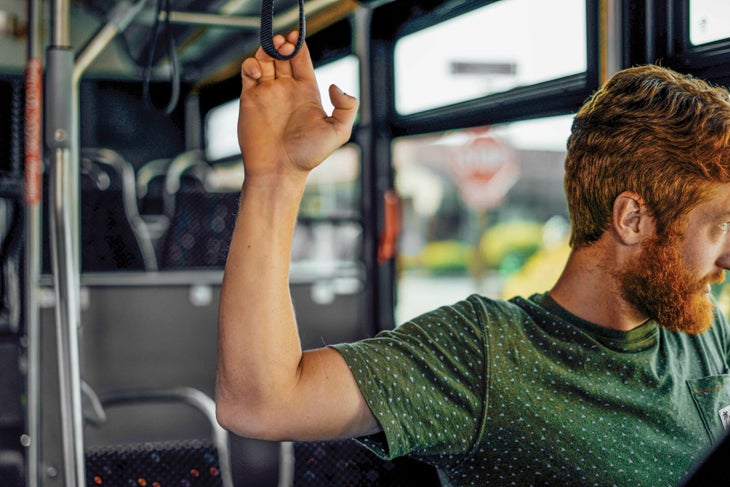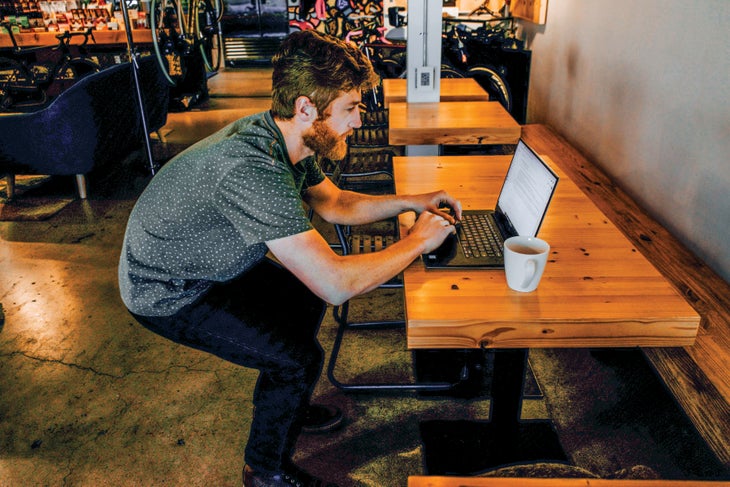7 Ways to (Secretly) Train for Climbing

To Dr. James Lee, a Chicago-based physical therapist who specializes in treating his fellow climbers, carrying groceries isn’t a chore. With plastic bags hanging from crooked fingers, he knows he’s doing more than just getting those bags from his car to his house; he’s also getting stronger for climbing.
Leta Dickinson, a USA Climbing certified coach who trains competitive teams at the Evanston Athletic Center, and Jasper Acosta, a coach of Brooklyn Boulders Chicago’s competitive teams, also employ similar “inconspicuous training” techniques. “It’s kind of a joke among climbers that we do, like, ‘one-finger training’ when we carry our grocery bags,” says Dickinson. But the joke has a lot of truth, according to Lee: “You’re just purely focusing on specific finger strength,” he explains. “It’s a great way to inconspicuously start training those fingers.”
Here are a handful of other inconspicuous-training exercises to help you cross-train, prevent injury, and even warm up en route to the cliff.
Technique No. 1: Train on a train

How to do it
The handles in public transit can be great makeshift fingerboards. Lee says not to hang your full body weight on the handles—instead, play with how much weight you’re supporting by leaning toward or away from the handle, using the tips or first pads of your fingers. Open-hand crimp for 10 seconds at a time, using all four fingers together or in combinations of one, two, or three.
How it helps
This exercise strengthens your fingers, plus engages your lats and biceps. “The more cycles you go through, the more of a burn you’ll feel in your forearms,” says Lee—helping you build strength and endurance for longer routes.
Read this: Learn to Train—A Complete Guide to Climbing Training
Technique No. 2: Desk squats
How to do it
Ditch the chair and squat at your desk. This might not work in an open office, but it’s plenty doable in a private room or cubicle. Remain in a low-squat position for several seconds at a time, says Lee: “Lean forward and hinge at your hips. Work 10–20 reps and squat like you are about to sit down on your chair, keeping your butt an inch from your seat, and then stand back up.”

How it helps
Squatting strengthens your hips, which serves two purposes, according to Lee: injury prevention and highstepping. “It will help with the hips, glute muscles, and even your back,” says Lee. “A lot of times when I see people with low-back pain, their hips are very weak, and so finding a way to engage the muscles around your spine as well as engaging your hips throughout the day is awesome.”
Lee adds that strengthening your hips can also improve your highstepping. “A lot of times, people have a hard time highstepping or they say their hips are really tight,” he says—however, this is often due to having weak hip flexors, an imbalance squats will address.
Technique No. 3: Finger curls
How to do it
Dickinson never leaves home without her latex resistance band—she whips it out during class, wraps the band around her thumb and index finger, opens and closes them, then repeats the drill with her middle and ring fingers. “Climbers typically develop muscle imbalances in their ring and middle fingers, so these are especially important to resistance-band train,” says Dickinson. A rubber band works too, though it offers less resistance.

Lee hangs the resistance band from his car’s rearview mirror and wraps the band around his fingers. When he’s stuck in traffic, he’ll have one hand on the wheel and the other doing finger curls, curling his fingers one by one, doing 3 sets of 10 reps per finger. Says Lee, “This is more tendon training or ligament training, so it doesn’t require a high resistance. It just requires high numbers of repetitions.”
How it helps
It takes six months to a year for collagen fiber in connective tissues to strengthen, and constantly climbing moderate routes and band-exercising your fingers will speed up the process. Lee urges consistency, not intensity: You want to constantly load your hands to develop stronger connective tissues and increased joint mobility over time.
Read this: 6 Weeks to Stronger Fingers with Jonathan Siegrist—The Campus Board
Technique No. 4: Self-massage with balls
How to do it
Lay a lacrosse or tennis ball on a flat surface like a desk. Now press your forearm onto the ball and roll back and forth. “Roll until slightly uncomfortable/general soreness is achieved, but avoid the aggressive rolling associated with sharper pain,” says Acosta.
How it helps
The lacrosse-ball technique helps break up the knots in sore, overused forearm muscles to aid with recovery, and gets your blood flowing as a pre-climb warm-up.
Technique No. 5: Powerball Warm-Up
How to do it
Warm up your hands, wrists, and forearms with a Powerball exerciser, which requires you to rotate your wrists while holding it. It’s unobtrusive enough to use while walking or driving to the gym. “[The] main goal is to get it going for one to three minutes at a moderate speed,” says Acosta.
How it helps
By encouraging blood flow, the Powerball helps you warm up and reduce the risk of tweaking a finger, etc.
Technique No. 6: Chair core
How to do it
When Dickinson is glued to her chair during a three-hour lecture and starts to drift off, she lifts herself up in her seat using her hands and holds that position for several seconds—an impromptu bent-leg L-seat variation. “No one can tell if you’re leaning forward or if you’re just really interested in the lecture,” she jokes.
How it helps
If you do it often enough, the exercise will help strengthen your core, which is beneficial on overhanging terrain.
Read this: Unsent—6 Training Hackz for Maximum Sendage
Technique No. 7: Wrist strengtheners
How to do it
With your palm facing forward, place your thumb over the back of your ring finger; it should look like you’re making the peace sign, but with your thumb resting on the back of the base of your ring finger. Bend your wrist down toward you, and then bring it back up. You can do this anywhere—standing in line, walking, reading, etc. Lee advises doing 30 reps on each hand; as you bend your wrist up, rotate it more toward your pinky side. You should feel muscle soreness on your outer forearm after a few reps.
How it helps
This exercise may help prevent wrist injuries, according to Lee, who has seen many overuse-related wrist strains in climbers. People tend to move their wrists toward the radial (thumb) side. But overdoing this motion may lead to muscle imbalance and injury by stressing the easily strained triangular fibrocartilage complex, which sits on the ulnar (pinky) side of your wrist. This exercise thus helps activate muscles in the ulnar side.
Pat Nabong is a photojournalist, video journalist, and writer in Chicago. Her work has appeared in various publications, including Chicago Magazine, Chicago Reader, and Narratively. When she’s not reporting, you’ll find her at the bouldering gym.
The post 7 Ways to (Secretly) Train for Climbing appeared first on Climbing.

